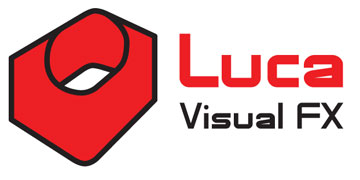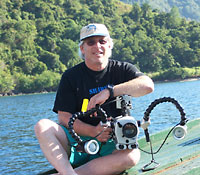|
|
   
| Review: - Luca FilmFX & Light Transitions |
May, 2010

Luca FilmFX & Light Transitions
www.lucavisualfx.com - $49.95 per set
Review by Steve Douglas
You see them all the time, be it television or theatrical films, light and film effects are frequently used both as effects on individual clips as well as transitional devices between scenes. In the past there have been some software companies that enabled you to recreate many of these lighting effects but it has been my experience that they tend to be both expensive and time consuming to make whether you are working in Final Cut Pro, Adobe After Effects or most any editing application.
Luca Visual FX is a new company that has simplified the entire process by developing their own Film and Light transitions that are easily applied and may be modified to taste. The Film Transition package comes with 30 individual effects and the Light transitions collection arrives with 33. Almost all the effects are less than 2 seconds long.
You then import them into your Final Cut browser as you would any import of files or folder and apply the transitions or film effects. Each of the Luca's Film FX or Light Transitions are, in essence, individual video clips with Alpha channels. These are then placed in the timeline above the clips you wish to place a transition or light modification on. And, as you would need to do when inserting or overwriting a clip be sure to have your bottom layers locked to avoid them being split by the Luca effects. Making it even simpler would be to just drag and drop the effect and move it to your desired location. If your media clip were on V1 then you would drag the effect or transition onto V2 above the cut.

Two of the Luca's Film FX have been placed over my media layer on V1.
All the clips contained within either of the two Film and Light transitions collections come in the animation codec with a 1920x1080 frame size. Each has its own active alpha channels. This makes using composite modes such as Add and Screen a viable option that affects the look of the transitions. It is certainly something to experiment with, as the number of looks that can be customized is just about infinite. I did find that changing the composite mode with several of the light leaks was more effective than with some of the other transition types.
The Luca's Light Transitions collection comes with a diversity of light transitions offering a variety of light lengths, colors and shapes. It is unfortunate that within the scope of this review I cannot show you movies of the FX in action but there are plenty of examples on their website.
On the left is the Light FX transition as seen in the viewer and on the right as it is applied on V2 centered between 2 clips. Additionally, a tint filter was applied to the Light FX transition. Since all the transitions are dragged in and placed over the V1 between the 2 clips, filters affecting their appearance can be placed on any of the transitions.
The Luca's Film FX transitions were easily used singly or stacked on top of each other. In addition to having a number of light leak effects there are also old countdown and multilayered scratched film effects which are dragged and dropped the same way as the others.
Film FX as seen in the Viewer before being applied to the video layers.
Light FX as seen in the Viewer before being applied to the video layers.
Any of these effects can be additionally customized in the Motion tab where you can modify the opacity, position, scale and even rotation to a degree. Even though each transition is its own clip you do not need to add handles using in & out markers. With snapping turned off I found it much easier to move the transitions above the media clips to where I wanted them to come in or go out. You can also drag either side to shorten them or adjust the constant speed of any of them as you would adjust speed with other media sources. Camera Light Leak Transitions support both constant and variable speed. Most Light Transitions work with Constant speed ONLY.
I did notice that reds and pinks in many of the transitions seemed predominant but that was no problem at all. One very cool feature is that you may apply any number of your filters to these transitions to get the exact color or glow you want. I found that by using the Sepia or Tint filters, I could radically change the appearance of any of these transitions.
The original clip on the left and with a Light Leak effect on the right. Too bad you aren't seeing it in motion.
With my 2x3 GHz Dual-Core Intel Xeon Mac Pro running the Radeon X1900 card and my timeline in Dynamic mode, I could not get the transition to play through without dropped frames. This left me to using Option/P to see the effect prior to rendering. In one test, a 1 sec, 5-frame transition took 25 seconds to render. Fairly fast as I didn't even have time to run to the fridge to get a Pepsi.
My bottom line for either the Luca's Light or Film FX is that we have a unique pair of collections here that are super easy to apply and use. However, tweaking them to get just the look you want, may take some time and practice. LUCA VISUAL FX has also released 9 New GPU accelerated plug-ins with Noise Industries. While there is a tutorial video on the Lucas Visual FX website which is well worth watching, the application of any of these transitions is completely intuitive and surely worth the price of the purchase.
 Steve Douglas is a certified Apple Pro for Final Cut Pro 7 and underwater videographer. A winner of the 1999 Pacific Coast Underwater Film Competition, 2003 IVIE competition, 2004 Los Angeles Underwater Photographic competition, and the prestigious 2005 International Beneath the Sea Film Competition, where he also won the Stan Waterman Award for Excellence in Underwater Videography and 'Diver of the Year', Steve was a safety diver on the feature film "The Deep Blue Sea", contributed footage to the Seaworld Park's Atlantis production, and productions for National Geographic and the History channels. Steve was a feature writer for Asian Diver Magazine and is one of the founding organizers of the San Diego UnderSea Film Exhibition. He is available for both private and group seminars for Final Cut Pro and leads underwater filming expeditions and African safaris with upcoming excursions to the Cocos Islands, Costa Rica, Lembeh Straits, Indonesia, and Wakatobi. Feel free to contact him if you are interested in joining Steve on any of these exciting trips. www.worldfilmsandtravel.com Steve Douglas is a certified Apple Pro for Final Cut Pro 7 and underwater videographer. A winner of the 1999 Pacific Coast Underwater Film Competition, 2003 IVIE competition, 2004 Los Angeles Underwater Photographic competition, and the prestigious 2005 International Beneath the Sea Film Competition, where he also won the Stan Waterman Award for Excellence in Underwater Videography and 'Diver of the Year', Steve was a safety diver on the feature film "The Deep Blue Sea", contributed footage to the Seaworld Park's Atlantis production, and productions for National Geographic and the History channels. Steve was a feature writer for Asian Diver Magazine and is one of the founding organizers of the San Diego UnderSea Film Exhibition. He is available for both private and group seminars for Final Cut Pro and leads underwater filming expeditions and African safaris with upcoming excursions to the Cocos Islands, Costa Rica, Lembeh Straits, Indonesia, and Wakatobi. Feel free to contact him if you are interested in joining Steve on any of these exciting trips. www.worldfilmsandtravel.com
copyright © Steve Douglas 2010
This article first appeared on www.kenstone.net and is reprinted here with permission.
All screen captures and textual references are the property and trademark of their creators/owners/publishers.
|